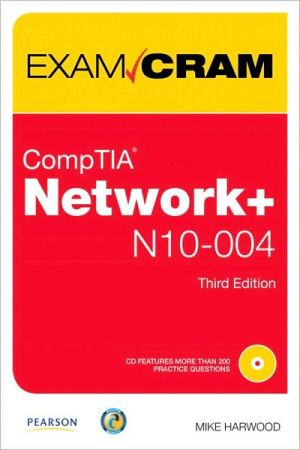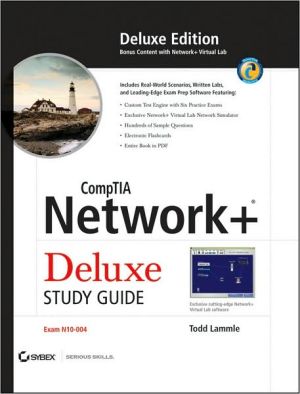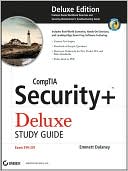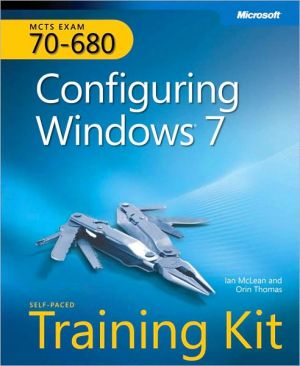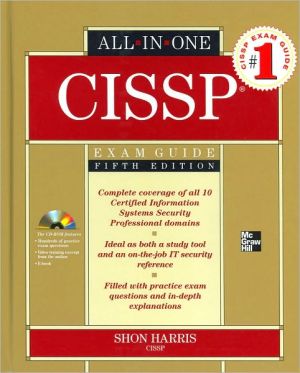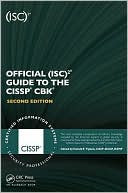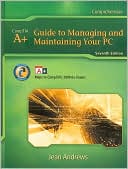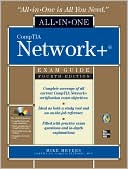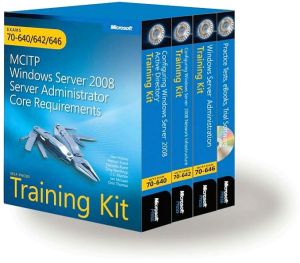CompTIA Network+ Exam Cram
The new edition of CompTIA Network+ Exam Cram is the first book to cover the Network+ 2009 exam.\ Covers the critical information you’ll need to know to score higher on your Network+ exam!\ \ Implement proven best practices for managing networks efficiently and reliably\ Thoroughly understand network hardware components, devices, cabling, and connectors\ Systematically review TCP/IP, related network protocols, and the OSI model\ Manage network operating systems and clients\ Identify network...
Search in google:
The new edition of CompTIA Network+ Exam Cram is the first book to cover the Network+ 2009 exam.Covers the critical information you’ll need to know to score higher on your Network+ exam! Implement proven best practices for managing networks efficiently and reliably Thoroughly understand network hardware components, devices, cabling, and connectors Systematically review TCP/IP, related network protocols, and the OSI model Manage network operating systems and clients Identify network vulnerabilities and configure network security to address them Use security tools such as cryptography and antivirus software Provide reliable, secure Internet access, WAN access, and VLAN support Implement disaster recovery plans that protect business continuity Troubleshoot network and Internet connectivity problems Efficiently document the network and provide high-quality user supportCD Features Test Engine! Detailed explanations of correct and incorrect answers Multiple test modes Random questions and order of answers Coverage of each Network+ exam objective
IntroductionIntroduction\ Welcome to the Network+ Exam Cram. This book is designed to prepare you to take—and pass—the CompTIA Network+ exam. The Network+ exam has become the leading introductory-level network certification available today. It is recognized by both employers and industry giants (such as Microsoft and Novell) as providing candidates with a solid foundation of networking concepts, terminology, and skills. The Network+ exam covers a broad range of networking concepts to prepare candidates for the technologies they are likely to work with in today’s network environments.\ About Network+ Exam Cram\ Exam Crams are designed to give you the information you need to know to prepare for the Network+ exam. They cut through the extra information, focusing on the areas you need to get through the exam. With this in mind, the elements within the Exam Cram titles are aimed at providing the exam information you need in the most succinct and accessible manner.\ In this light, this book is organized to closely follow the actual CompTIA objectives. As such, it is easy to find the information required for each of the specified CompTIA Network+ objectives. The objective focus design used by this Exam Cram is an important feature because the information you need to know is easily identifiable and accessible. To see what we mean, compare the CompTIA objectives to the book’s layout, and you will see that the facts are right where you would expect them to be.\ Within the chapters themselves, potential exam hot spots are clearly highlighted with Exam Alerts. They have been carefully placed to let you know that the surrounding discussion is an important area for the exam. To further help you prepare for the exam, a Cram Sheet is included that can be used in the final stages of test preparation. Be sure to pay close attention to the bulleted points on the Cram Sheet, because they pinpoint the technologies and facts you probably will encounter on the test.\ Finally, great effort has gone into the end-of-chapter questions and practice tests to ensure that they accurately represent the look and feel of the ones you will see on the real Network+ exam. Be sure, before taking the exam, that you are comfortable with both the format and content of the questions provided in this book.\ About the Network+ Exam\ The Network+ (2009 Edition) exam is a revised version of the original exam. The new Network+ objectives are aimed toward those who have nine months of experience in network support and administration. CompTIA believes that new Network+ candidates will require more hands-on experience in network administration and troubleshooting, but this should not discourage those who do not. Quite simply, the nature of the questions on the new exam is not dissimilar to the old, and you can get by without actual hands-on experience. Still, a little hands-on experience never hurt anyone and will certainly add to your confidence going into the exam.\ You will have a maximum of 90 minutes to answer the 72 questions on the exam. The allotted time is quite generous, so when you are finished, you probably will have time to double-check a few of the answers you were unsure of. By the time the dust settles, you will need a minimum score of 646 to pass the Network+ exam. This is on a scale of 100 to 900.\ One of the best things about the Network+ certification is that after you pass the exam, you are certified for life. There is no need to ever recertify. This fact can make the cost of taking the Network+ exam a little easier to swallow. For more information on the specifics of the Network+ exam, refer to CompTIA’s main website at http://www.comptia.org/certification/.\ Booking and Taking the Network+ Certification Exam\ Unfortunately, testing is not free. You’re charged $239 for each test you take, whether you pass or fail. In the United States and Canada, tests are administered by Sylvan Prometric or VUE testing services. To book a test with Prometric or to locate a Prometric testing center near you, refer to the website at http://securereg3.prometric.com/ or call 1-888-895-6116. To access the VUE contact information and book an exam, refer to the website at http://www.vue.com or call 1-877-551-7587. When booking an exam, you need to provide the following information:\ \ Your name as you would like it to appear on your certificate.\ Your Social Security or Social Insurance number.\ Contact phone numbers (to be called in case of a problem).\ Mailing address, which identifies the address to which you want your certificate mailed.\ Exam number and title.\ Email address for contact purposes. This often is the fastest and most effective means of contacting you. Many clients require it for registration.\ Credit-card information so that you can pay online. Vouchers can be redeemed by calling the respective testing center.\ \ What to Expect from the Exam\ If you haven’t taken a certification test, the process can be a little unnerving. Even if you’ve taken numerous tests, it is not much better. Mastering the inner mental game often can be as much of a battle as knowing the material. Knowing what to expect before heading in can make the process a little more comfortable.\ Certification tests are administered on a computer system at a Prometric or VUE authorized testing center. The format of the exams is straightforward: Each question has several possible answers to choose from. In fact, the questions in this book provide a very good example of the types of questions you can expect on the exam. If you are comfortable with them, the test should hold few surprises. Many of the questions vary in length; some of them are longer scenario questions, whereas others are short and to the point. Read the questions carefully; the longer questions often have a key point that will lead you to the correct answer.\ Most of the questions on the Network+ exam require you to choose a single correct answer, but a few require multiple answers. When there are multiple correct answers, a message at the bottom of the screen prompts you to “choose all that apply.” Be sure to read these messages.\ A Few Exam Day Details\ It is recommended that you arrive at the examination room at least 15 minutes early, although a few minutes earlier certainly would not hurt. This will give you time to prepare and will give the test administrator time to answer any questions you might have before the test begins. Many people suggest that you review the most critical information about the test you’re taking just before the test. (Exam Cram books provide a reference—the Cram Sheet, located inside the front of this book—that lists the essential information from the book in distilled form.) Arriving a few minutes early will give you some time to compose yourself and mentally review this critical information.\ You will be asked to provide two forms of ID, one of which must be a photo ID. Both of the identifications you choose should have a signature. You also might need to sign in when you arrive and sign out when you leave.\ Be warned: The rules are very clear about what you can and cannot take into the examination room. Books, laptops, note sheets, and so on are not allowed in the examination room. The test administrator will hold these items, to be returned after you complete the exam. You might receive either a wipe board or a pen and a single piece of paper for making notes during the exam. The test administrator will ensure that no paper is removed from the examination room.\ After the Test\ Whether you want it or not, as soon as you finish your test, your score is displayed on the computer screen. In addition to the results appearing on the computer screen, a hard copy of the report is printed for you. Like the onscreen report, the hard copy displays the results of your exam and provides a summary of how you did on each section and on each technology. If you were unsuccessful, this summary can help you determine the areas you need to brush up on.\ When you pass the Network+ exam, you will have earned the Network+ certification, and your certificate will be mailed to you within a few weeks. Should you not receive your certificate and information packet within five weeks of passing your exam, contact CompTIA at fulfillment@comptia.org, or call 1-630-268-1818 and ask for the fulfillment department.\ Last-Minute Exam Tips\ Studying for a certification exam really is no different from studying for any other exam, but a few hints and tips can give you the edge on exam day:\ \ Read all the material: CompTIA has been known to include material not expressly specified in the objectives. This book has included additional information not reflected in the objectives in an effort to give you the best possible preparation for the examination.\ Watch for the Exam Tips and Notes: The Network+ objectives include a wide range of technologies. Exam Tips and Notes found throughout each chapter are designed to pull out exam-related hot spots. These can be your best friends when preparing for the exam.\ Use the questions to assess your knowledge: Don’t just read the chapter content; use the exam questions to find out what you know and what you don’t. If you are struggling, study some more, review, and then assess your knowledge again.\ Review the exam objectives: Develop your own questions and examples for each topic listed. If you can develop and answer several questions for each topic, you should not find it difficult to pass the exam.\ \ Good luck!\ © Copyright Pearson Education. All rights reserved.
Introduction... 1Self-Assessment... 7Chapter 1:Introduction to Networking..................................................................... 13Introduction.............................................................................. 14LANs, WANs, MANs, and WPANs............................................ 14LANs........................................................................... 14WANs......................................................................... 15Metropolitan Area Networks (MANs)............................... 15WPANs....................................................................... 15Network Models....................................................................... 16Peer-to-Peer Networking Model...................................... 16Client/Server Networking Model...................................... 16Comparing Peer-to-Peer and Client/Server Network Models 17Centralized and Distributed Computing....................................... 18Virtual Private Networks (VPNs)................................................. 18Components of the VPN Connection.............................. 19VPN Pros and Cons..................................................... 20Virtual Local Area Networks (VLANs)......................................... 21VLAN Membership....................................................... 23Network Topologies.................................................................. 26Bus Topology............................................................... 26Ring Topology.............................................................. 27Star Topology............................................................... 28Wired Mesh Topology................................................... 30Wireless Topologies..................................................... 31Point-to-Point, Point-to-Multipoint, and Wireless Mesh Topologies 33Hybrid Topologies......................................................... 36Review and Test Yourself.......................................................... 37The Facts.................................................................... 37Key Terms................................................................... 38Exam Prep Questions................................................... 39Answers to Exam Prep Questions................................. 41Need to Know More?................................................................ 42Chapter 2:Cabling, Connectors, and Ethernet Standards......................................... 43Introduction.............................................................................. 45General Media Considerations................................................... 45Broadband Versus Baseband........................................ 46Simplex, Half Duplex, and Full Duplex............................ 46Media Interference........................................................ 46Attenuation.................................................................. 47Data Transmission Rates.............................................. 48Network Media......................................................................... 48Twisted-Pair Cabling..................................................... 49Coaxial........................................................................ 52Fiber-Optic Cable......................................................... 53Plenum Cables............................................................. 56Media Connectors.................................................................... 56BNC Connectors.......................................................... 56RJ-11 Connectors......................................................... 57RJ-45 Connectors......................................................... 58F-Type Connectors and RG-59 and RG-6........................ 59Fiber Connectors.......................................................... 59RS-232 Standard.......................................................... 61IEEE 1394................................................................... 62Universal Serial Bus (USB)............................................ 62568A and 568B Wiring Standards.............................................. 63Straight Versus Crossover Cable................................................ 64Rollover and Loopback Cables................................................... 66Loopback Cable........................................................... 66Components of Wiring Distribution............................................. 66Network Cross-Connects............................................... 67Horizontal Cabling........................................................ 67Vertical Cable.............................................................. 69Patch Panels............................................................... 69Type 66 and Type 110 Punchdown Blocks...................... 71MDF and IDF............................................................... 71Demarc, Demarc Extension, and Smart Jacks................ 72Verify Wiring Installation and Termination........................ 74IEEE and Overview of Networking Standards............................... 75IEEE 802.2 Standard.................................................... 76IEEE 802.3x Standard Characteristics............................ 76802.3 Ethernet Standards.......................................................... 8110BaseT...................................................................... 8110BaseFL.................................................................... 82Fast Ethernet............................................................... 82Gigabit Ethernet: 1000BaseX......................................... 841000BaseT.................................................................. 8510 Gigabit Ethernet....................................................... 8610GBaseT................................................................... 88Review and Test Yourself.......................................................... 88The Facts.................................................................... 89Key Terms................................................................... 90Exam Prep Questions................................................... 90Answers to Exam Prep Questions................................. 93Need to Know More?................................................................ 94Chapter 3:Networking Components and Devices..................................................... 95Introduction.............................................................................. 96Hubs....................................................................................... 96MSAU..................................................................................... 97Switches................................................................................. 98Hub and Switch Cabling................................................ 99Bridges.................................................................................. 100Bridge Placement and Bridging Loops.......................... 101Types of Bridges......................................................... 101Routers.................................................................................. 102Gateways.............................................................................. 103Network Cards........................................................................ 104Types of Network Interfaces......................................... 104Installing Network Cards.............................................. 105Media Converters.................................................................... 106Wireless Access Points.......................................................... 107Modems................................................................................ 108Firewalls................................................................................ 110DHCP Server.......................................................................... 111Repeaters.............................................................................. 112Specialized Network Devices................................................... 112Multilayer and Content Switches.................................. 113Intrusion Detection and Prevention Systems.................. 114Load Balancer............................................................ 115Multifunction Network Devices...................................... 115DNS Server................................................................ 116Bandwidth Shaper....................................................... 117Proxy Server.............................................................. 118CSUs/DSUs............................................................... 120Network Devices Summary.......................................... 121Advanced Features of a Switch................................................ 123Power over Ethernet (PoE)........................................... 123Spanning Tree............................................................ 124Trunking..................................................................... 125Port Mirroring............................................................. 126Port Authentication..................................................... 126Review and Test Yourself......................................................... 126The Facts.................................................................. 126Key Terms................................................................. 128Exam Prep Questions................................................. 129Answers to Exam Prep Questions................................ 131Need to Know More?............................................................... 132Chapter 4:OSI Model and Network Protocols........................................................ 133Introduction............................................................................ 134The OSI Seven-Layer Model..................................................... 134Physical Layer (Layer 1).............................................. 135Data Link Layer (Layer 2)............................................ 136Network Layer (Layer 3).............................................. 136Transport Layer (Layer 4)............................................. 137Session Layer (Layer 5).............................................. 138Presentation Layer (Layer 6)........................................ 138Application Layer (Layer 7).......................................... 138OSI Model Summary................................................... 139Identifying the OSI Layers at Which Various Network Components Operate................................................................ 140Connectionless and Connection-Oriented Protocols................... 140Introduction to Protocols.......................................................... 141Internet Protocol (IP)................................................... 142Transmission Control Protocol (TCP)............................ 142User Datagram Protocol (UDP).................................... 143File Transfer Protocol (FTP)......................................... 144Secure File Transfer Protocol (SFTP)............................ 146Trivial File Transfer Protocol (TFTP).............................. 146Simple Mail Transfer Protocol (SMTP).......................... 147Hypertext Transfer Protocol (HTTP).............................. 147Hypertext Transfer Protocol Secure (HTTPS)................. 148Post Office Protocol Version 3/Internet Message Access Protocol Version 4 (POP3/IMAP4)...................................... 148Telnet........................................................................ 149Secure Shell (SSH)..................................................... 150Internet Control Message Protocol (ICMP)..................... 150Address Resolution Protocol (ARP)/Reverse Address Resolution Protocol (RARP)............................................... 151Network Time Protocol (NTP)....................................... 152Network News Transfer Protocol (NNTP)....................... 153Secure Copy Protocol (SCP)....................................... 153Lightweight Directory Access Protocol (LDAP).............. 154Internet Group Management Protocol (IGMP)................ 154Domain Name System (DNS)...................................... 154Simple Network Management Protocol (SNMP)............. 161Dynamic Host Configuration Protocol (DHCP)................ 164Transport Layer Security............................................. 166Session Initiation Protocol (SIP)/Real-Time Transport Protocol (RTP).................................................................. 166TCP/IP Protocol Suite Summary.................................. 168Review and Test Yourself......................................................... 170The Facts.................................................................. 171Key Terms................................................................. 172Exam Prep Questions................................................. 173Answers to Exam Prep Questions................................ 175Need to Know More?............................................................... 176Chapter 5:TCP/IP Routing and Addressing........................................................... 177Introduction............................................................................ 179IP Addressing............................................................. 179IPv4........................................................................... 180IP Address Classes.................................................... 180Subnet Mask Assignment........................................... 181Subnetting................................................................. 182Identifying the Differences Between IPv4 Public and Private Networks....................................................................... 183Private Address Ranges.............................................. 184Classless Interdomain Routing (CIDR).......................... 185Default Gateways....................................................... 185IPv4 Address Types.................................................... 187IPv6 Addressing.......................................................... 187Comparing IPv4 and IPv6 Addressing............................ 191Assigning IP Addresses.......................................................... 191Static Addressing....................................................... 191Dynamic Addressing................................................... 192BOOT Protocol (BOOTP)............................................. 194APIPA....................................................................... 194Identifying MAC Addresses...................................................... 195NAT, PAT, and SNAT.............................................................. 196Network Address Translation (NAT).............................. 196PAT and SNAT........................................................... 197TCP/UDP Port Functions......................................................... 198Managing TCP/IP Routing........................................................ 200The Default Gateway................................................... 200Routing Tables........................................................... 200Static Routing............................................................ 201Dynamic Routing........................................................ 202Review and Test Yourself......................................................... 206The Facts.................................................................. 206Key Terms................................................................. 207Exam Prep Questions................................................. 209Answers to Exam Prep Questions................................ 211Need to Know More?............................................................... 212Chapter 6:WAN Technologies and Internet Access............................................... 213WAN Technologies................................................................. 214Switching Methods..................................................... 214Integrated Services Digital Network (ISDN).................... 217T-carrier Lines............................................................ 218SONET/OCx Levels.................................................... 220X.25 and Frame Relay................................................. 222Asynchronous Transfer Mode (ATM)............................. 224Summary of WAN Technologies................................... 224Internet Access Technologies.................................................. 226xDSL Internet Access................................................. 226Cable Internet Access................................................. 229Broadband Security Considerations.............................. 232POTS Internet Access................................................ 232The Public Switched Telephone Network (PSTN)........... 235Satellite Internet Access............................................. 235Wireless Internet Access............................................ 237MPLS........................................................................ 238Review and Test Yourself......................................................... 239The Facts.................................................................. 239Key Terms................................................................. 240Exam Prep Questions................................................. 241Answers to Exam Prep Questions................................ 243Need to Know More?............................................................... 244Chapter 7:Wireless Networking........................................................................... 245Introduction............................................................................ 246Wireless Access Points.............................................. 247Working with APs....................................................... 248Wireless Antennas..................................................... 249Antenna Ratings......................................................... 250Antenna Coverage....................................................... 250Wireless Radio Channels........................................................ 252Data Rate Versus Throughput...................................... 254Factors Affecting Wireless Signals........................................... 255Interference Types...................................................... 255Spread-Spectrum Technology...................................... 257Orthogonal Frequency Division Multiplexing................... 258Beacon Management Frame........................................ 258802.11 Wireless Standards...................................................... 259The Magic Behind 802.11n.......................................... 261Summary of 802.11 Wireless Standards....................... 262Securing Wireless Networks.................................................... 263Wired Equivalent Privacy (WEP).................................. 263Wi-Fi Protected Access (WPA)................................... 264802.1X....................................................................... 265Temporal Key Integrity Protocol................................... 266Establishing Communications Between Wireless Devices.......... 266Configuring the Wireless Connection........................................ 269Access Point Coverage........................................................... 271Wireless Signal Quality........................................................... 273Wireless Troubleshooting Checklist.......................................... 274Infrared Wireless Networking.................................................... 275Bluetooth............................................................................... 276Review and Test Yourself......................................................... 277The Facts.................................................................. 277Key Terms................................................................. 278Exam Prep Questions................................................. 279Answers to Exam Prep Questions................................ 281Need to Know More?............................................................... 282Chapter 8:Network Performance Optimization....................................................... 283Introduction............................................................................ 284What Is Uptime?..................................................................... 285The Risks.............................................................................. 287Fault Tolerance....................................................................... 287Disk-Level Fault Tolerance........................................... 288Server and Services Fault Tolerance............................. 293Link Redundancy........................................................ 295Using Uninterruptible Power Supplies........................... 296Disaster Recovery................................................................... 297Full Backup................................................................ 297Differential Backup...................................................... 298Incremental Backup.................................................... 299Tape Rotations........................................................... 300Backup Best Practices............................................... 300Hot and Cold Spares................................................... 301Hot, Warm, and Cold Sites.......................................... 302Network Optimization Strategies.............................................. 304QoS.......................................................................... 304Traffic Shaping............................................................ 305Caching Engines........................................................ 306Working with Command-Line Utilities........................................ 307Troubleshooting with Diagnostic Utilities....................... 307The Trace Route Utility (tracert/traceroute).................... 309ping........................................................................... 312ARP.......................................................................... 317The netstat Command................................................. 320nbtstat....................................................................... 326The ipconfig Command................................................ 327ifconfig....................................................................... 329nslookup.................................................................... 330dig............................................................................. 331mtr............................................................................ 333The host Command..................................................... 333The route Utility.......................................................... 333Review and Test Yourself......................................................... 335The Facts.................................................................. 335Key Terms................................................................. 337Exam Prep Questions................................................. 338Answers to Exam Prep Questions................................ 341Need to Know More?............................................................... 342Chapter 9:Network Security................................................................................ 343Introduction............................................................................ 345Firewalls................................................................................ 345Stateful and Stateless Firewalls................................... 347Packet-Filtering Firewalls............................................ 348Circuit-Level Firewalls.................................................. 349Application Layer Firewalls.......................................... 349Comparing Firewall Types............................................ 349Firewall Wrap-up......................................................... 350Demilitarized Zones (Perimeter Network)....................... 350Other Security Devices............................................................ 351Honeypots and Honeynets........................................... 353Access Control Overview......................................................... 354Mandatory Access Control (MAC)................................ 354Discretionary Access Control (DAC)............................. 354Rule-Based Access Control (RBAC)............................. 355Role-Based Access Control (RoBAC)........................... 356MAC Filtering............................................................. 356TCP/IP Filtering.......................................................... 357Tunneling and Encryption........................................................ 358Point-to-Point Tunneling Protocol (PPTP)...................... 359Layer 2 Tunneling Protocol (L2TP)................................ 359IPSec........................................................................ 361Remote-Access Protocols and Services................................... 362Remote Access Service (RAS).................................... 362SLIP.......................................................................... 363PPP.......................................................................... 364PPPoE...................................................................... 365Remote-Control Protocols............................................ 365Authentication, Authorization, and Accounting (AAA)................. 366Passwords and Password Policies............................... 369Kerberos Authentication.............................................. 371Public Key Infrastructure............................................. 373RADIUS and TACACS+............................................... 376Remote Authentication Protocols............................................. 377Physical Security................................................................... 378Server Room Access.................................................. 379Secured Versus Unsecured Protocols...................................... 381Managing Common Security Threats........................................ 382More on Viruses......................................................... 383More on Worms and Trojan Horses.............................. 384Denial of Service and Distributed Denial of Service Attacks 385Other Common Attacks............................................... 386An Ounce of Prevention............................................... 388Review and Test Yourself......................................................... 390The Facts.................................................................. 390Key Terms................................................................. 391Exam Prep Questions................................................. 392Answers to Exam Prep Questions................................ 394Need to Know More?............................................................... 395Chapter 10:Network Management Tools and Documentation.................................... 397Introduction............................................................................ 398Documentation Management................................................... 399Wiring Schematics..................................................... 401Physical and Logical Network Diagrams....................... 404Baselines................................................................... 407Policies, Procedures, Configurations, and Regulations... 409Monitoring Network Performance.............................................. 413Common Reasons to Monitor Networks........................ 413Packet Sniffers........................................................... 415Throughput Testing..................................................... 415Port Scanners............................................................ 417Network Performance, Load, and Stress Testing............ 420Tracking Event Logs.................................................... 422Networking Tools.................................................................... 426Wire Crimpers, Strippers, and Snips............................. 427Voltage Event Recorder............................................... 428Temperature Monitors................................................. 429Toner Probes.............................................................. 430Protocol Analyzer....................................................... 431Media/Cable Testers................................................... 432TDR and OTDR........................................................... 432Multimeter.................................................................. 433Network Qualification Tester........................................ 434Butt Set..................................................................... 434Wireless Detection..................................................... 434Review and Test Yourself......................................................... 435The Facts.................................................................. 435Key Terms................................................................. 436Exam Prep Questions................................................. 437Answers to Exam Questions....................................... 440Need to Know More?............................................................... 441Chapter 11:Troubleshooting and Supporting the Network......................................... 443Introduction............................................................................ 444Troubleshooting Steps and Procedures..................................... 445Information Gathering: Identify Symptoms and Problems 445Identify the Affected Areas of the Network..................... 446Determine if Anything Has Changed............................. 446Establish the Most Probable Cause.............................. 447Determine if Escalation Is Necessary........................... 447Create an Action Plan and Solution Identifying Potential Effects............................................................................. 448Implement and Test the Solution.................................. 449Identify the Results and Effects of the Solution.............. 450Document the Solution and the Entire Process.............. 450Troubleshooting the Network.................................................... 451Troubleshooting Wiring................................................ 451Wiring Issues............................................................. 453Troubleshooting Infrastructure Hardware........................ 455Configuring and Troubleshooting Client Connectivity....... 457Troubleshooting an Incorrect VLAN............................... 462Topology Errors...................................................................... 463Star Topology............................................................. 464Ring Topology............................................................ 465Bus Network Errors..................................................... 467Mesh Network Errors.................................................. 468Issue Escalation..................................................................... 469Review and Test Yourself......................................................... 471The Facts.................................................................. 471Key Terms................................................................. 472Exam Prep Questions................................................. 473Answers to Exam Prep Questions................................ 476Need to Know More?............................................................... 477Practice Exam 1................................................................................. 479Answers to Practice Exam 1............................................................... 499Answers at a Glance............................................................... 499Answers and Explanations...................................................... 500Practice Exam 2................................................................................. 515Answers to Practice Exam 2............................................................... 533Answers at a Glance............................................................... 533Answers and Explanations...................................................... 534Glossary............................................................................................ 553TOC, 2/13/09, 9780789737960
